Lean Process Reengineering in Textile Industry: Bangladesh Case Study
VerifiedAdded on 2022/12/12
|42
|15619
|451
Report
AI Summary
This report provides a comprehensive analysis of lean process reengineering within the textile industry, specifically examining the Bangladeshi garments sector. The study investigates the application of Lean Production methods to reduce waste and improve efficiency, focusing on a case study where a significant percentage of orders were lost. The research details the diagnostic process, the identification of value-added and non-value-added metrics, and the development of a Value Stream Analysis. It prioritizes Lean tools like 5S and Production Cells based on cost, time, and implementation viability. The report highlights the potential benefits of these tools, such as reduced processing times, increased production capacity, and improved job performance. The study also explores the application of Six Sigma methodology to address quality issues and reduce defects. The report includes an introduction to lean manufacturing principles, a review of the garments industry in Bangladesh, research methodology, data analysis, findings, discussion, and conclusions, offering valuable insights into process improvement and waste reduction strategies within the textile industry.
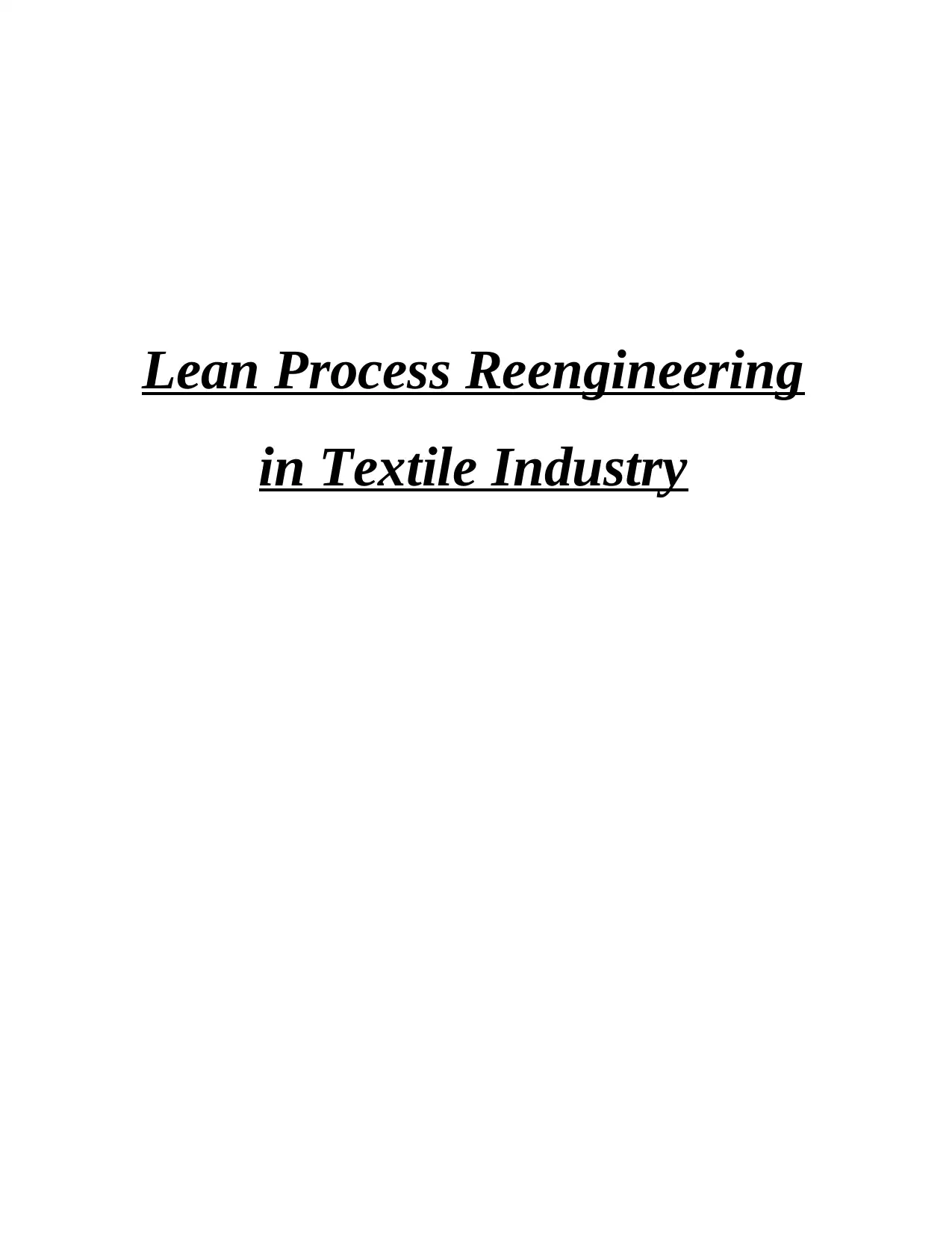
Lean Process Reengineering
in Textile Industry
in Textile Industry
Paraphrase This Document
Need a fresh take? Get an instant paraphrase of this document with our AI Paraphraser
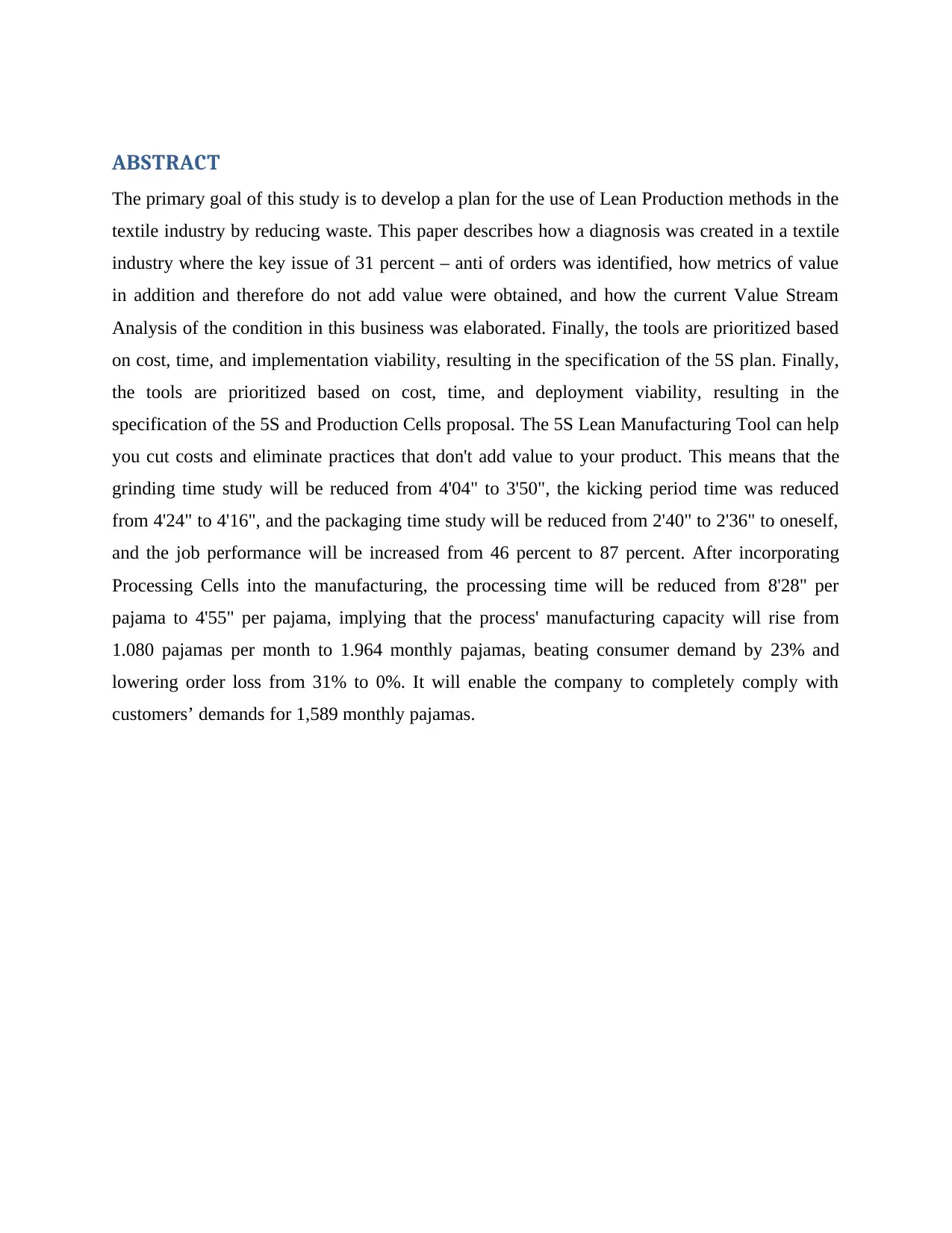
ABSTRACT
The primary goal of this study is to develop a plan for the use of Lean Production methods in the
textile industry by reducing waste. This paper describes how a diagnosis was created in a textile
industry where the key issue of 31 percent – anti of orders was identified, how metrics of value
in addition and therefore do not add value were obtained, and how the current Value Stream
Analysis of the condition in this business was elaborated. Finally, the tools are prioritized based
on cost, time, and implementation viability, resulting in the specification of the 5S plan. Finally,
the tools are prioritized based on cost, time, and deployment viability, resulting in the
specification of the 5S and Production Cells proposal. The 5S Lean Manufacturing Tool can help
you cut costs and eliminate practices that don't add value to your product. This means that the
grinding time study will be reduced from 4'04" to 3'50", the kicking period time was reduced
from 4'24" to 4'16", and the packaging time study will be reduced from 2'40" to 2'36" to oneself,
and the job performance will be increased from 46 percent to 87 percent. After incorporating
Processing Cells into the manufacturing, the processing time will be reduced from 8'28" per
pajama to 4'55" per pajama, implying that the process' manufacturing capacity will rise from
1.080 pajamas per month to 1.964 monthly pajamas, beating consumer demand by 23% and
lowering order loss from 31% to 0%. It will enable the company to completely comply with
customers’ demands for 1,589 monthly pajamas.
The primary goal of this study is to develop a plan for the use of Lean Production methods in the
textile industry by reducing waste. This paper describes how a diagnosis was created in a textile
industry where the key issue of 31 percent – anti of orders was identified, how metrics of value
in addition and therefore do not add value were obtained, and how the current Value Stream
Analysis of the condition in this business was elaborated. Finally, the tools are prioritized based
on cost, time, and implementation viability, resulting in the specification of the 5S plan. Finally,
the tools are prioritized based on cost, time, and deployment viability, resulting in the
specification of the 5S and Production Cells proposal. The 5S Lean Manufacturing Tool can help
you cut costs and eliminate practices that don't add value to your product. This means that the
grinding time study will be reduced from 4'04" to 3'50", the kicking period time was reduced
from 4'24" to 4'16", and the packaging time study will be reduced from 2'40" to 2'36" to oneself,
and the job performance will be increased from 46 percent to 87 percent. After incorporating
Processing Cells into the manufacturing, the processing time will be reduced from 8'28" per
pajama to 4'55" per pajama, implying that the process' manufacturing capacity will rise from
1.080 pajamas per month to 1.964 monthly pajamas, beating consumer demand by 23% and
lowering order loss from 31% to 0%. It will enable the company to completely comply with
customers’ demands for 1,589 monthly pajamas.
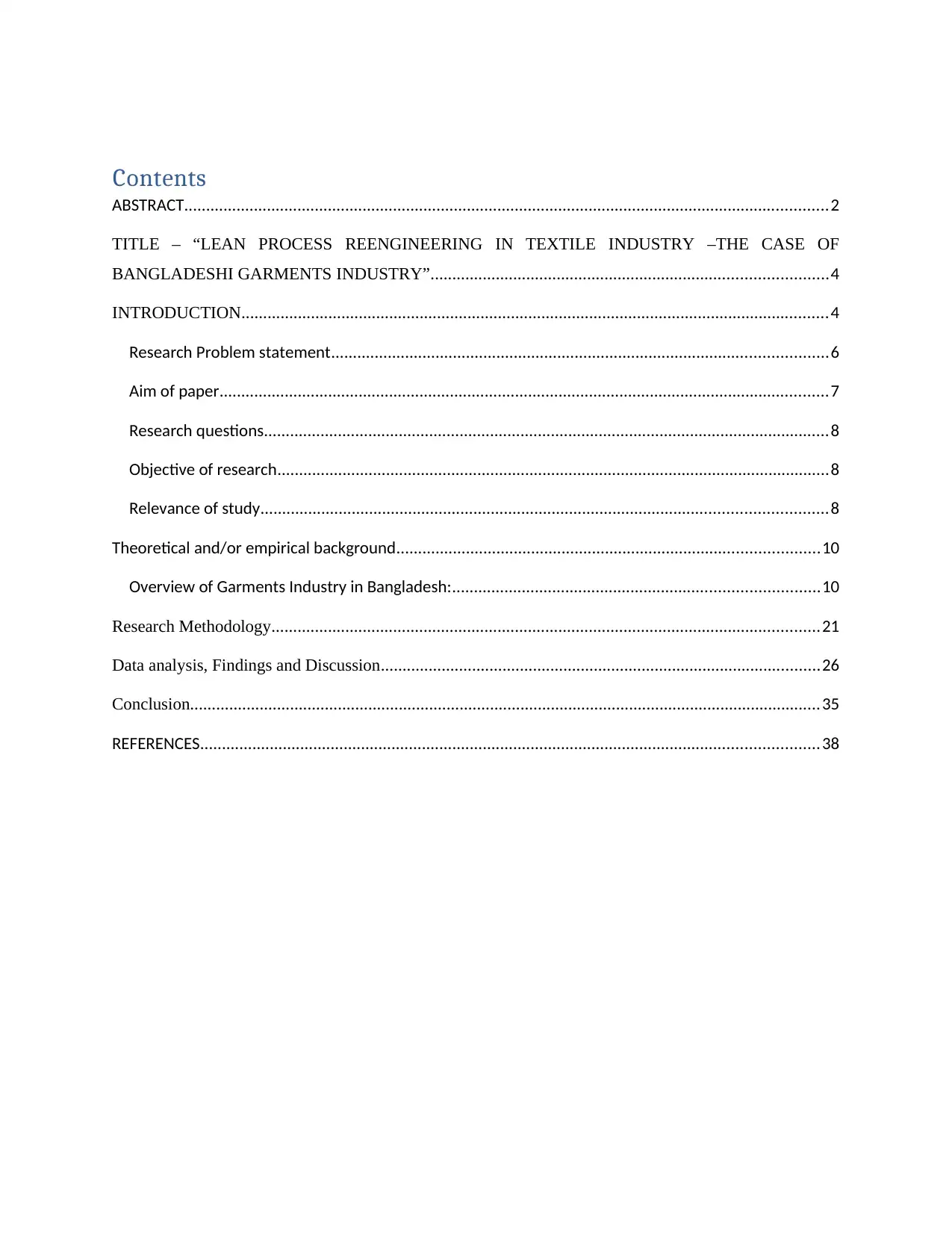
Contents
ABSTRACT....................................................................................................................................................2
TITLE – “LEAN PROCESS REENGINEERING IN TEXTILE INDUSTRY –THE CASE OF
BANGLADESHI GARMENTS INDUSTRY”...........................................................................................4
INTRODUCTION.......................................................................................................................................4
Research Problem statement..................................................................................................................6
Aim of paper............................................................................................................................................7
Research questions..................................................................................................................................8
Objective of research...............................................................................................................................8
Relevance of study..................................................................................................................................8
Theoretical and/or empirical background.................................................................................................10
Overview of Garments Industry in Bangladesh:....................................................................................10
Research Methodology..............................................................................................................................21
Data analysis, Findings and Discussion.....................................................................................................26
Conclusion.................................................................................................................................................35
REFERENCES..............................................................................................................................................38
ABSTRACT....................................................................................................................................................2
TITLE – “LEAN PROCESS REENGINEERING IN TEXTILE INDUSTRY –THE CASE OF
BANGLADESHI GARMENTS INDUSTRY”...........................................................................................4
INTRODUCTION.......................................................................................................................................4
Research Problem statement..................................................................................................................6
Aim of paper............................................................................................................................................7
Research questions..................................................................................................................................8
Objective of research...............................................................................................................................8
Relevance of study..................................................................................................................................8
Theoretical and/or empirical background.................................................................................................10
Overview of Garments Industry in Bangladesh:....................................................................................10
Research Methodology..............................................................................................................................21
Data analysis, Findings and Discussion.....................................................................................................26
Conclusion.................................................................................................................................................35
REFERENCES..............................................................................................................................................38
⊘ This is a preview!⊘
Do you want full access?
Subscribe today to unlock all pages.

Trusted by 1+ million students worldwide
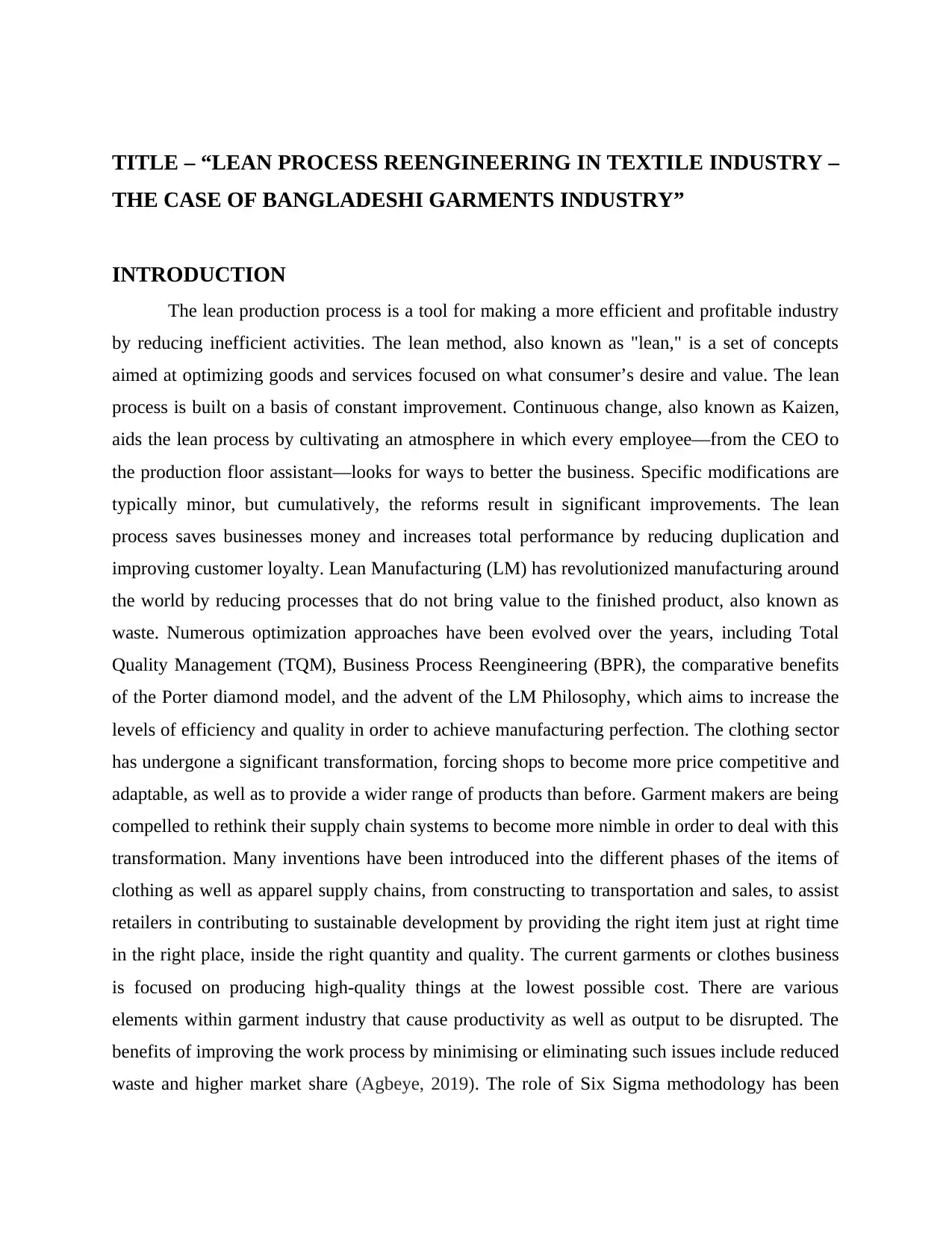
TITLE – “LEAN PROCESS REENGINEERING IN TEXTILE INDUSTRY –
THE CASE OF BANGLADESHI GARMENTS INDUSTRY”
INTRODUCTION
The lean production process is a tool for making a more efficient and profitable industry
by reducing inefficient activities. The lean method, also known as "lean," is a set of concepts
aimed at optimizing goods and services focused on what consumer’s desire and value. The lean
process is built on a basis of constant improvement. Continuous change, also known as Kaizen,
aids the lean process by cultivating an atmosphere in which every employee—from the CEO to
the production floor assistant—looks for ways to better the business. Specific modifications are
typically minor, but cumulatively, the reforms result in significant improvements. The lean
process saves businesses money and increases total performance by reducing duplication and
improving customer loyalty. Lean Manufacturing (LM) has revolutionized manufacturing around
the world by reducing processes that do not bring value to the finished product, also known as
waste. Numerous optimization approaches have been evolved over the years, including Total
Quality Management (TQM), Business Process Reengineering (BPR), the comparative benefits
of the Porter diamond model, and the advent of the LM Philosophy, which aims to increase the
levels of efficiency and quality in order to achieve manufacturing perfection. The clothing sector
has undergone a significant transformation, forcing shops to become more price competitive and
adaptable, as well as to provide a wider range of products than before. Garment makers are being
compelled to rethink their supply chain systems to become more nimble in order to deal with this
transformation. Many inventions have been introduced into the different phases of the items of
clothing as well as apparel supply chains, from constructing to transportation and sales, to assist
retailers in contributing to sustainable development by providing the right item just at right time
in the right place, inside the right quantity and quality. The current garments or clothes business
is focused on producing high-quality things at the lowest possible cost. There are various
elements within garment industry that cause productivity as well as output to be disrupted. The
benefits of improving the work process by minimising or eliminating such issues include reduced
waste and higher market share (Agbeye, 2019). The role of Six Sigma methodology has been
THE CASE OF BANGLADESHI GARMENTS INDUSTRY”
INTRODUCTION
The lean production process is a tool for making a more efficient and profitable industry
by reducing inefficient activities. The lean method, also known as "lean," is a set of concepts
aimed at optimizing goods and services focused on what consumer’s desire and value. The lean
process is built on a basis of constant improvement. Continuous change, also known as Kaizen,
aids the lean process by cultivating an atmosphere in which every employee—from the CEO to
the production floor assistant—looks for ways to better the business. Specific modifications are
typically minor, but cumulatively, the reforms result in significant improvements. The lean
process saves businesses money and increases total performance by reducing duplication and
improving customer loyalty. Lean Manufacturing (LM) has revolutionized manufacturing around
the world by reducing processes that do not bring value to the finished product, also known as
waste. Numerous optimization approaches have been evolved over the years, including Total
Quality Management (TQM), Business Process Reengineering (BPR), the comparative benefits
of the Porter diamond model, and the advent of the LM Philosophy, which aims to increase the
levels of efficiency and quality in order to achieve manufacturing perfection. The clothing sector
has undergone a significant transformation, forcing shops to become more price competitive and
adaptable, as well as to provide a wider range of products than before. Garment makers are being
compelled to rethink their supply chain systems to become more nimble in order to deal with this
transformation. Many inventions have been introduced into the different phases of the items of
clothing as well as apparel supply chains, from constructing to transportation and sales, to assist
retailers in contributing to sustainable development by providing the right item just at right time
in the right place, inside the right quantity and quality. The current garments or clothes business
is focused on producing high-quality things at the lowest possible cost. There are various
elements within garment industry that cause productivity as well as output to be disrupted. The
benefits of improving the work process by minimising or eliminating such issues include reduced
waste and higher market share (Agbeye, 2019). The role of Six Sigma methodology has been
Paraphrase This Document
Need a fresh take? Get an instant paraphrase of this document with our AI Paraphraser
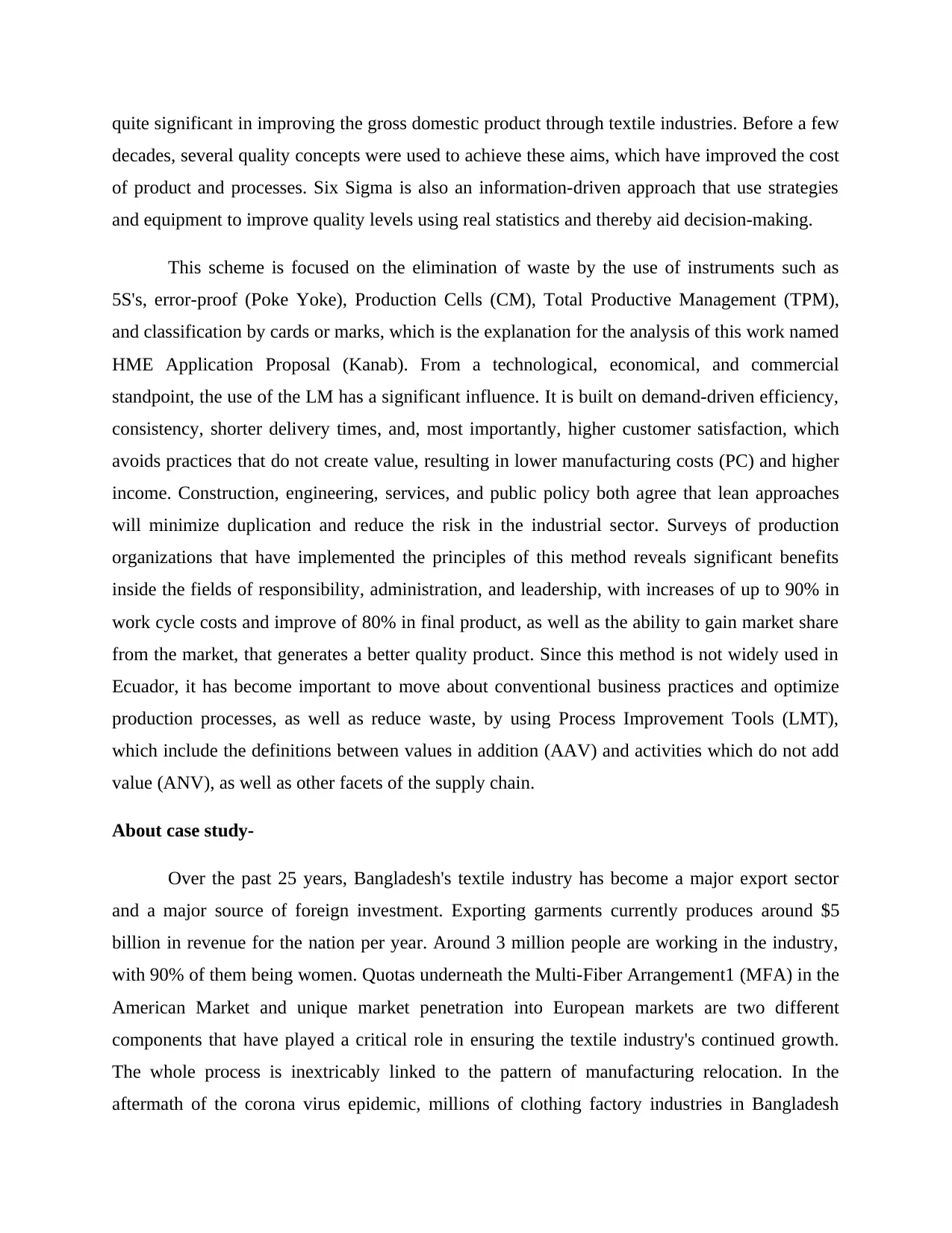
quite significant in improving the gross domestic product through textile industries. Before a few
decades, several quality concepts were used to achieve these aims, which have improved the cost
of product and processes. Six Sigma is also an information-driven approach that use strategies
and equipment to improve quality levels using real statistics and thereby aid decision-making.
This scheme is focused on the elimination of waste by the use of instruments such as
5S's, error-proof (Poke Yoke), Production Cells (CM), Total Productive Management (TPM),
and classification by cards or marks, which is the explanation for the analysis of this work named
HME Application Proposal (Kanab). From a technological, economical, and commercial
standpoint, the use of the LM has a significant influence. It is built on demand-driven efficiency,
consistency, shorter delivery times, and, most importantly, higher customer satisfaction, which
avoids practices that do not create value, resulting in lower manufacturing costs (PC) and higher
income. Construction, engineering, services, and public policy both agree that lean approaches
will minimize duplication and reduce the risk in the industrial sector. Surveys of production
organizations that have implemented the principles of this method reveals significant benefits
inside the fields of responsibility, administration, and leadership, with increases of up to 90% in
work cycle costs and improve of 80% in final product, as well as the ability to gain market share
from the market, that generates a better quality product. Since this method is not widely used in
Ecuador, it has become important to move about conventional business practices and optimize
production processes, as well as reduce waste, by using Process Improvement Tools (LMT),
which include the definitions between values in addition (AAV) and activities which do not add
value (ANV), as well as other facets of the supply chain.
About case study-
Over the past 25 years, Bangladesh's textile industry has become a major export sector
and a major source of foreign investment. Exporting garments currently produces around $5
billion in revenue for the nation per year. Around 3 million people are working in the industry,
with 90% of them being women. Quotas underneath the Multi-Fiber Arrangement1 (MFA) in the
American Market and unique market penetration into European markets are two different
components that have played a critical role in ensuring the textile industry's continued growth.
The whole process is inextricably linked to the pattern of manufacturing relocation. In the
aftermath of the corona virus epidemic, millions of clothing factory industries in Bangladesh
decades, several quality concepts were used to achieve these aims, which have improved the cost
of product and processes. Six Sigma is also an information-driven approach that use strategies
and equipment to improve quality levels using real statistics and thereby aid decision-making.
This scheme is focused on the elimination of waste by the use of instruments such as
5S's, error-proof (Poke Yoke), Production Cells (CM), Total Productive Management (TPM),
and classification by cards or marks, which is the explanation for the analysis of this work named
HME Application Proposal (Kanab). From a technological, economical, and commercial
standpoint, the use of the LM has a significant influence. It is built on demand-driven efficiency,
consistency, shorter delivery times, and, most importantly, higher customer satisfaction, which
avoids practices that do not create value, resulting in lower manufacturing costs (PC) and higher
income. Construction, engineering, services, and public policy both agree that lean approaches
will minimize duplication and reduce the risk in the industrial sector. Surveys of production
organizations that have implemented the principles of this method reveals significant benefits
inside the fields of responsibility, administration, and leadership, with increases of up to 90% in
work cycle costs and improve of 80% in final product, as well as the ability to gain market share
from the market, that generates a better quality product. Since this method is not widely used in
Ecuador, it has become important to move about conventional business practices and optimize
production processes, as well as reduce waste, by using Process Improvement Tools (LMT),
which include the definitions between values in addition (AAV) and activities which do not add
value (ANV), as well as other facets of the supply chain.
About case study-
Over the past 25 years, Bangladesh's textile industry has become a major export sector
and a major source of foreign investment. Exporting garments currently produces around $5
billion in revenue for the nation per year. Around 3 million people are working in the industry,
with 90% of them being women. Quotas underneath the Multi-Fiber Arrangement1 (MFA) in the
American Market and unique market penetration into European markets are two different
components that have played a critical role in ensuring the textile industry's continued growth.
The whole process is inextricably linked to the pattern of manufacturing relocation. In the
aftermath of the corona virus epidemic, millions of clothing factory industries in Bangladesh
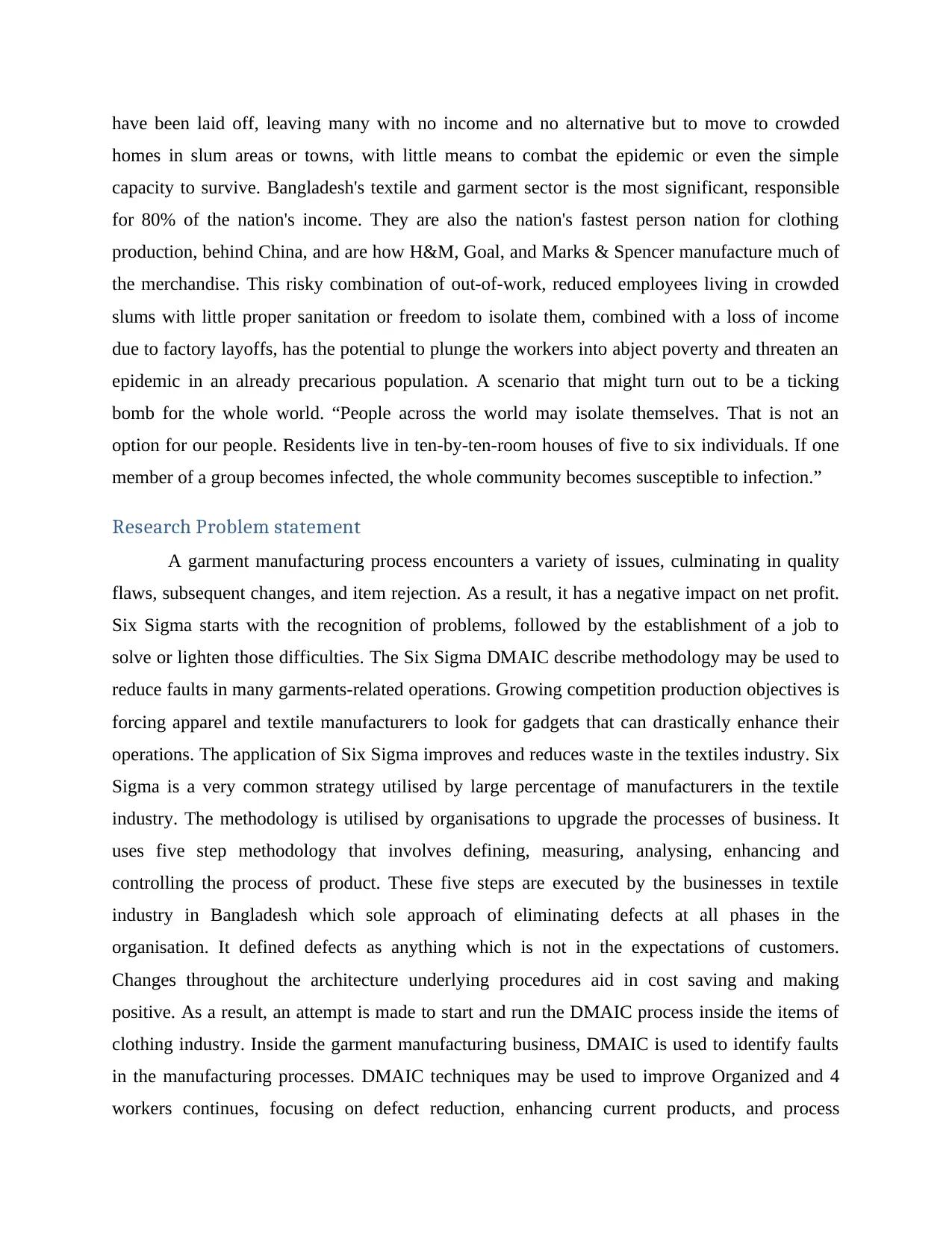
have been laid off, leaving many with no income and no alternative but to move to crowded
homes in slum areas or towns, with little means to combat the epidemic or even the simple
capacity to survive. Bangladesh's textile and garment sector is the most significant, responsible
for 80% of the nation's income. They are also the nation's fastest person nation for clothing
production, behind China, and are how H&M, Goal, and Marks & Spencer manufacture much of
the merchandise. This risky combination of out-of-work, reduced employees living in crowded
slums with little proper sanitation or freedom to isolate them, combined with a loss of income
due to factory layoffs, has the potential to plunge the workers into abject poverty and threaten an
epidemic in an already precarious population. A scenario that might turn out to be a ticking
bomb for the whole world. “People across the world may isolate themselves. That is not an
option for our people. Residents live in ten-by-ten-room houses of five to six individuals. If one
member of a group becomes infected, the whole community becomes susceptible to infection.”
Research Problem statement
A garment manufacturing process encounters a variety of issues, culminating in quality
flaws, subsequent changes, and item rejection. As a result, it has a negative impact on net profit.
Six Sigma starts with the recognition of problems, followed by the establishment of a job to
solve or lighten those difficulties. The Six Sigma DMAIC describe methodology may be used to
reduce faults in many garments-related operations. Growing competition production objectives is
forcing apparel and textile manufacturers to look for gadgets that can drastically enhance their
operations. The application of Six Sigma improves and reduces waste in the textiles industry. Six
Sigma is a very common strategy utilised by large percentage of manufacturers in the textile
industry. The methodology is utilised by organisations to upgrade the processes of business. It
uses five step methodology that involves defining, measuring, analysing, enhancing and
controlling the process of product. These five steps are executed by the businesses in textile
industry in Bangladesh which sole approach of eliminating defects at all phases in the
organisation. It defined defects as anything which is not in the expectations of customers.
Changes throughout the architecture underlying procedures aid in cost saving and making
positive. As a result, an attempt is made to start and run the DMAIC process inside the items of
clothing industry. Inside the garment manufacturing business, DMAIC is used to identify faults
in the manufacturing processes. DMAIC techniques may be used to improve Organized and 4
workers continues, focusing on defect reduction, enhancing current products, and process
homes in slum areas or towns, with little means to combat the epidemic or even the simple
capacity to survive. Bangladesh's textile and garment sector is the most significant, responsible
for 80% of the nation's income. They are also the nation's fastest person nation for clothing
production, behind China, and are how H&M, Goal, and Marks & Spencer manufacture much of
the merchandise. This risky combination of out-of-work, reduced employees living in crowded
slums with little proper sanitation or freedom to isolate them, combined with a loss of income
due to factory layoffs, has the potential to plunge the workers into abject poverty and threaten an
epidemic in an already precarious population. A scenario that might turn out to be a ticking
bomb for the whole world. “People across the world may isolate themselves. That is not an
option for our people. Residents live in ten-by-ten-room houses of five to six individuals. If one
member of a group becomes infected, the whole community becomes susceptible to infection.”
Research Problem statement
A garment manufacturing process encounters a variety of issues, culminating in quality
flaws, subsequent changes, and item rejection. As a result, it has a negative impact on net profit.
Six Sigma starts with the recognition of problems, followed by the establishment of a job to
solve or lighten those difficulties. The Six Sigma DMAIC describe methodology may be used to
reduce faults in many garments-related operations. Growing competition production objectives is
forcing apparel and textile manufacturers to look for gadgets that can drastically enhance their
operations. The application of Six Sigma improves and reduces waste in the textiles industry. Six
Sigma is a very common strategy utilised by large percentage of manufacturers in the textile
industry. The methodology is utilised by organisations to upgrade the processes of business. It
uses five step methodology that involves defining, measuring, analysing, enhancing and
controlling the process of product. These five steps are executed by the businesses in textile
industry in Bangladesh which sole approach of eliminating defects at all phases in the
organisation. It defined defects as anything which is not in the expectations of customers.
Changes throughout the architecture underlying procedures aid in cost saving and making
positive. As a result, an attempt is made to start and run the DMAIC process inside the items of
clothing industry. Inside the garment manufacturing business, DMAIC is used to identify faults
in the manufacturing processes. DMAIC techniques may be used to improve Organized and 4
workers continues, focusing on defect reduction, enhancing current products, and process
⊘ This is a preview!⊘
Do you want full access?
Subscribe today to unlock all pages.

Trusted by 1+ million students worldwide
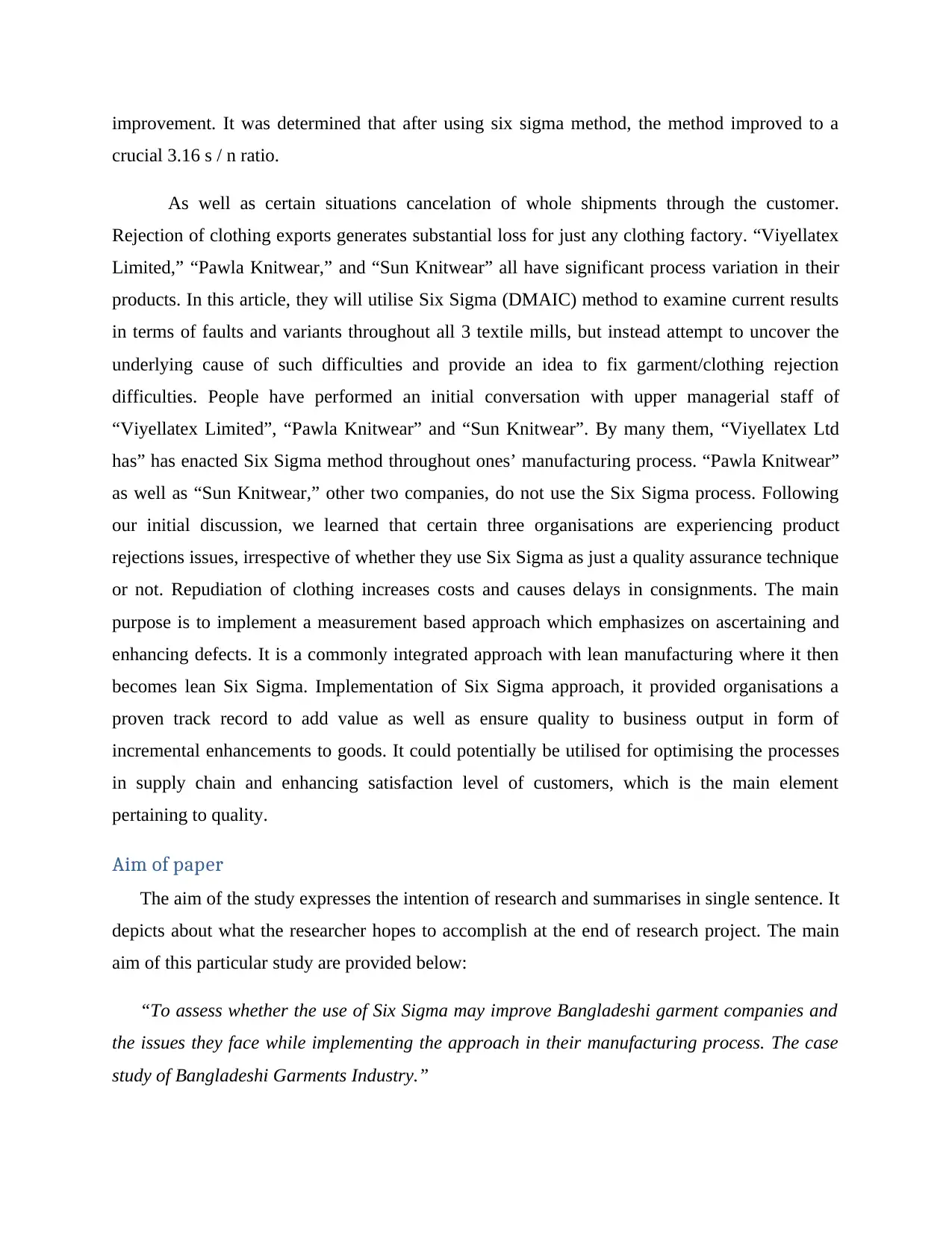
improvement. It was determined that after using six sigma method, the method improved to a
crucial 3.16 s / n ratio.
As well as certain situations cancelation of whole shipments through the customer.
Rejection of clothing exports generates substantial loss for just any clothing factory. “Viyellatex
Limited,” “Pawla Knitwear,” and “Sun Knitwear” all have significant process variation in their
products. In this article, they will utilise Six Sigma (DMAIC) method to examine current results
in terms of faults and variants throughout all 3 textile mills, but instead attempt to uncover the
underlying cause of such difficulties and provide an idea to fix garment/clothing rejection
difficulties. People have performed an initial conversation with upper managerial staff of
“Viyellatex Limited”, “Pawla Knitwear” and “Sun Knitwear”. By many them, “Viyellatex Ltd
has” has enacted Six Sigma method throughout ones’ manufacturing process. “Pawla Knitwear”
as well as “Sun Knitwear,” other two companies, do not use the Six Sigma process. Following
our initial discussion, we learned that certain three organisations are experiencing product
rejections issues, irrespective of whether they use Six Sigma as just a quality assurance technique
or not. Repudiation of clothing increases costs and causes delays in consignments. The main
purpose is to implement a measurement based approach which emphasizes on ascertaining and
enhancing defects. It is a commonly integrated approach with lean manufacturing where it then
becomes lean Six Sigma. Implementation of Six Sigma approach, it provided organisations a
proven track record to add value as well as ensure quality to business output in form of
incremental enhancements to goods. It could potentially be utilised for optimising the processes
in supply chain and enhancing satisfaction level of customers, which is the main element
pertaining to quality.
Aim of paper
The aim of the study expresses the intention of research and summarises in single sentence. It
depicts about what the researcher hopes to accomplish at the end of research project. The main
aim of this particular study are provided below:
“To assess whether the use of Six Sigma may improve Bangladeshi garment companies and
the issues they face while implementing the approach in their manufacturing process. The case
study of Bangladeshi Garments Industry.”
crucial 3.16 s / n ratio.
As well as certain situations cancelation of whole shipments through the customer.
Rejection of clothing exports generates substantial loss for just any clothing factory. “Viyellatex
Limited,” “Pawla Knitwear,” and “Sun Knitwear” all have significant process variation in their
products. In this article, they will utilise Six Sigma (DMAIC) method to examine current results
in terms of faults and variants throughout all 3 textile mills, but instead attempt to uncover the
underlying cause of such difficulties and provide an idea to fix garment/clothing rejection
difficulties. People have performed an initial conversation with upper managerial staff of
“Viyellatex Limited”, “Pawla Knitwear” and “Sun Knitwear”. By many them, “Viyellatex Ltd
has” has enacted Six Sigma method throughout ones’ manufacturing process. “Pawla Knitwear”
as well as “Sun Knitwear,” other two companies, do not use the Six Sigma process. Following
our initial discussion, we learned that certain three organisations are experiencing product
rejections issues, irrespective of whether they use Six Sigma as just a quality assurance technique
or not. Repudiation of clothing increases costs and causes delays in consignments. The main
purpose is to implement a measurement based approach which emphasizes on ascertaining and
enhancing defects. It is a commonly integrated approach with lean manufacturing where it then
becomes lean Six Sigma. Implementation of Six Sigma approach, it provided organisations a
proven track record to add value as well as ensure quality to business output in form of
incremental enhancements to goods. It could potentially be utilised for optimising the processes
in supply chain and enhancing satisfaction level of customers, which is the main element
pertaining to quality.
Aim of paper
The aim of the study expresses the intention of research and summarises in single sentence. It
depicts about what the researcher hopes to accomplish at the end of research project. The main
aim of this particular study are provided below:
“To assess whether the use of Six Sigma may improve Bangladeshi garment companies and
the issues they face while implementing the approach in their manufacturing process. The case
study of Bangladeshi Garments Industry.”
Paraphrase This Document
Need a fresh take? Get an instant paraphrase of this document with our AI Paraphraser
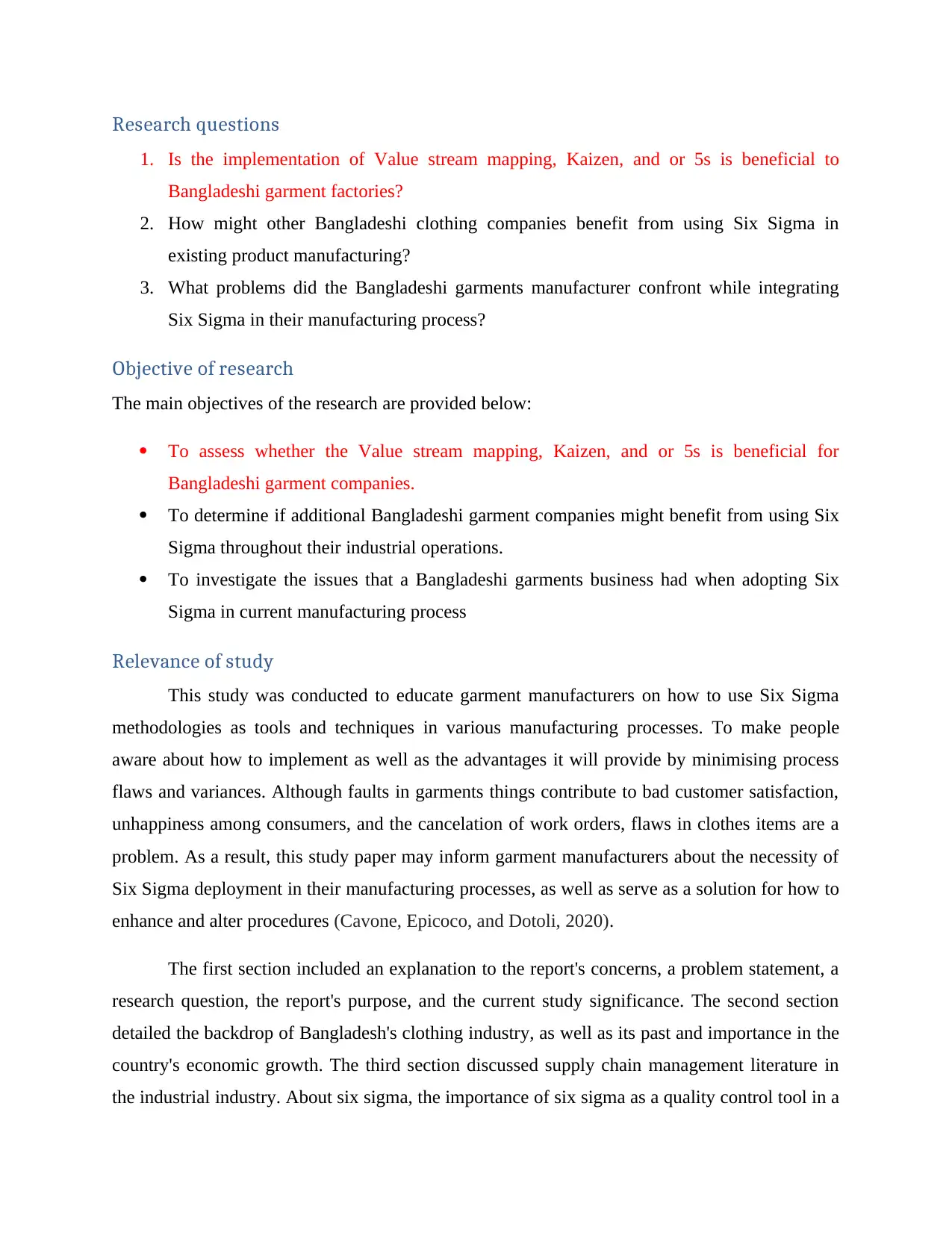
Research questions
1. Is the implementation of Value stream mapping, Kaizen, and or 5s is beneficial to
Bangladeshi garment factories?
2. How might other Bangladeshi clothing companies benefit from using Six Sigma in
existing product manufacturing?
3. What problems did the Bangladeshi garments manufacturer confront while integrating
Six Sigma in their manufacturing process?
Objective of research
The main objectives of the research are provided below:
To assess whether the Value stream mapping, Kaizen, and or 5s is beneficial for
Bangladeshi garment companies.
To determine if additional Bangladeshi garment companies might benefit from using Six
Sigma throughout their industrial operations.
To investigate the issues that a Bangladeshi garments business had when adopting Six
Sigma in current manufacturing process
Relevance of study
This study was conducted to educate garment manufacturers on how to use Six Sigma
methodologies as tools and techniques in various manufacturing processes. To make people
aware about how to implement as well as the advantages it will provide by minimising process
flaws and variances. Although faults in garments things contribute to bad customer satisfaction,
unhappiness among consumers, and the cancelation of work orders, flaws in clothes items are a
problem. As a result, this study paper may inform garment manufacturers about the necessity of
Six Sigma deployment in their manufacturing processes, as well as serve as a solution for how to
enhance and alter procedures (Cavone, Epicoco, and Dotoli, 2020).
The first section included an explanation to the report's concerns, a problem statement, a
research question, the report's purpose, and the current study significance. The second section
detailed the backdrop of Bangladesh's clothing industry, as well as its past and importance in the
country's economic growth. The third section discussed supply chain management literature in
the industrial industry. About six sigma, the importance of six sigma as a quality control tool in a
1. Is the implementation of Value stream mapping, Kaizen, and or 5s is beneficial to
Bangladeshi garment factories?
2. How might other Bangladeshi clothing companies benefit from using Six Sigma in
existing product manufacturing?
3. What problems did the Bangladeshi garments manufacturer confront while integrating
Six Sigma in their manufacturing process?
Objective of research
The main objectives of the research are provided below:
To assess whether the Value stream mapping, Kaizen, and or 5s is beneficial for
Bangladeshi garment companies.
To determine if additional Bangladeshi garment companies might benefit from using Six
Sigma throughout their industrial operations.
To investigate the issues that a Bangladeshi garments business had when adopting Six
Sigma in current manufacturing process
Relevance of study
This study was conducted to educate garment manufacturers on how to use Six Sigma
methodologies as tools and techniques in various manufacturing processes. To make people
aware about how to implement as well as the advantages it will provide by minimising process
flaws and variances. Although faults in garments things contribute to bad customer satisfaction,
unhappiness among consumers, and the cancelation of work orders, flaws in clothes items are a
problem. As a result, this study paper may inform garment manufacturers about the necessity of
Six Sigma deployment in their manufacturing processes, as well as serve as a solution for how to
enhance and alter procedures (Cavone, Epicoco, and Dotoli, 2020).
The first section included an explanation to the report's concerns, a problem statement, a
research question, the report's purpose, and the current study significance. The second section
detailed the backdrop of Bangladesh's clothing industry, as well as its past and importance in the
country's economic growth. The third section discussed supply chain management literature in
the industrial industry. About six sigma, the importance of six sigma as a quality control tool in a
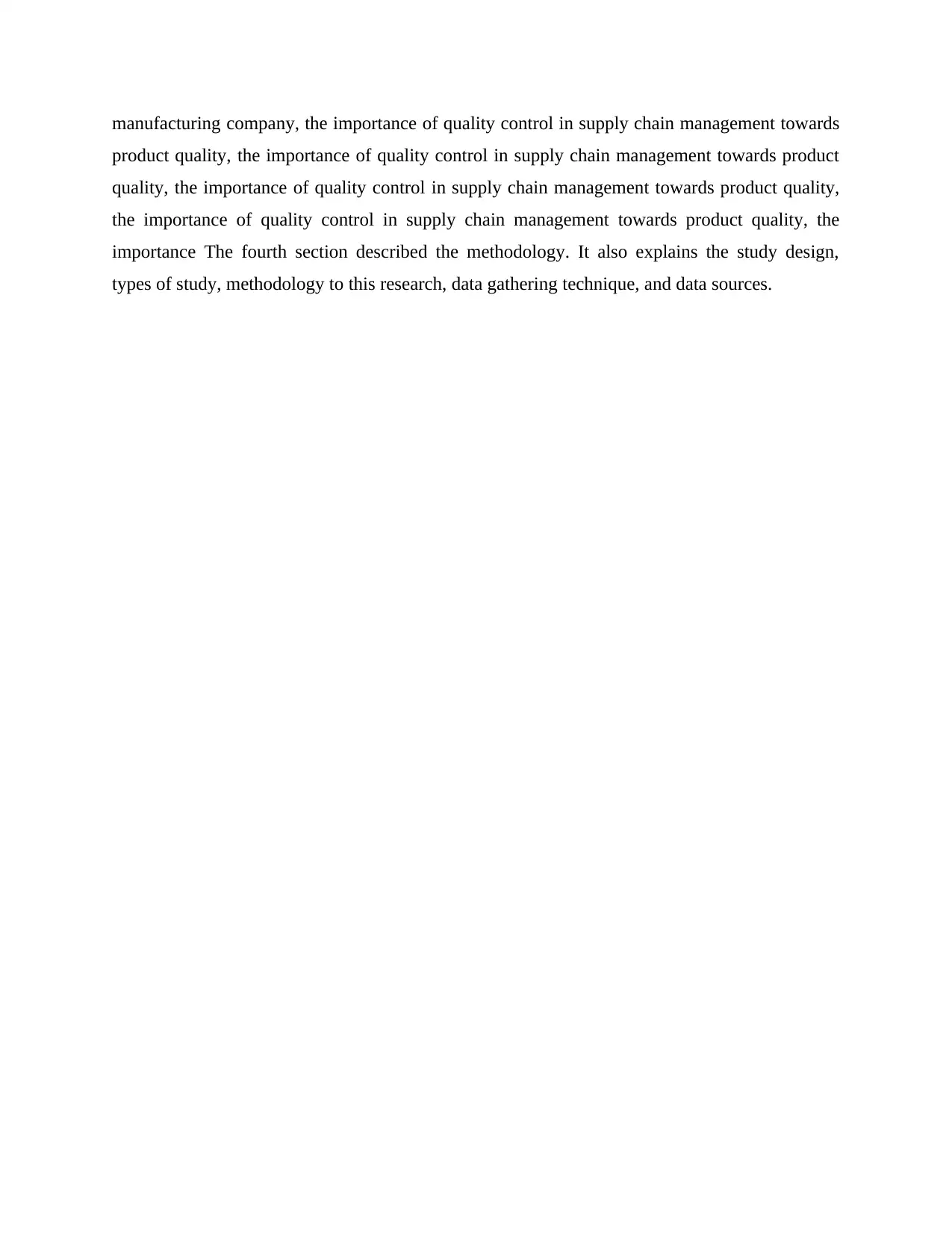
manufacturing company, the importance of quality control in supply chain management towards
product quality, the importance of quality control in supply chain management towards product
quality, the importance of quality control in supply chain management towards product quality,
the importance of quality control in supply chain management towards product quality, the
importance The fourth section described the methodology. It also explains the study design,
types of study, methodology to this research, data gathering technique, and data sources.
product quality, the importance of quality control in supply chain management towards product
quality, the importance of quality control in supply chain management towards product quality,
the importance of quality control in supply chain management towards product quality, the
importance The fourth section described the methodology. It also explains the study design,
types of study, methodology to this research, data gathering technique, and data sources.
⊘ This is a preview!⊘
Do you want full access?
Subscribe today to unlock all pages.

Trusted by 1+ million students worldwide
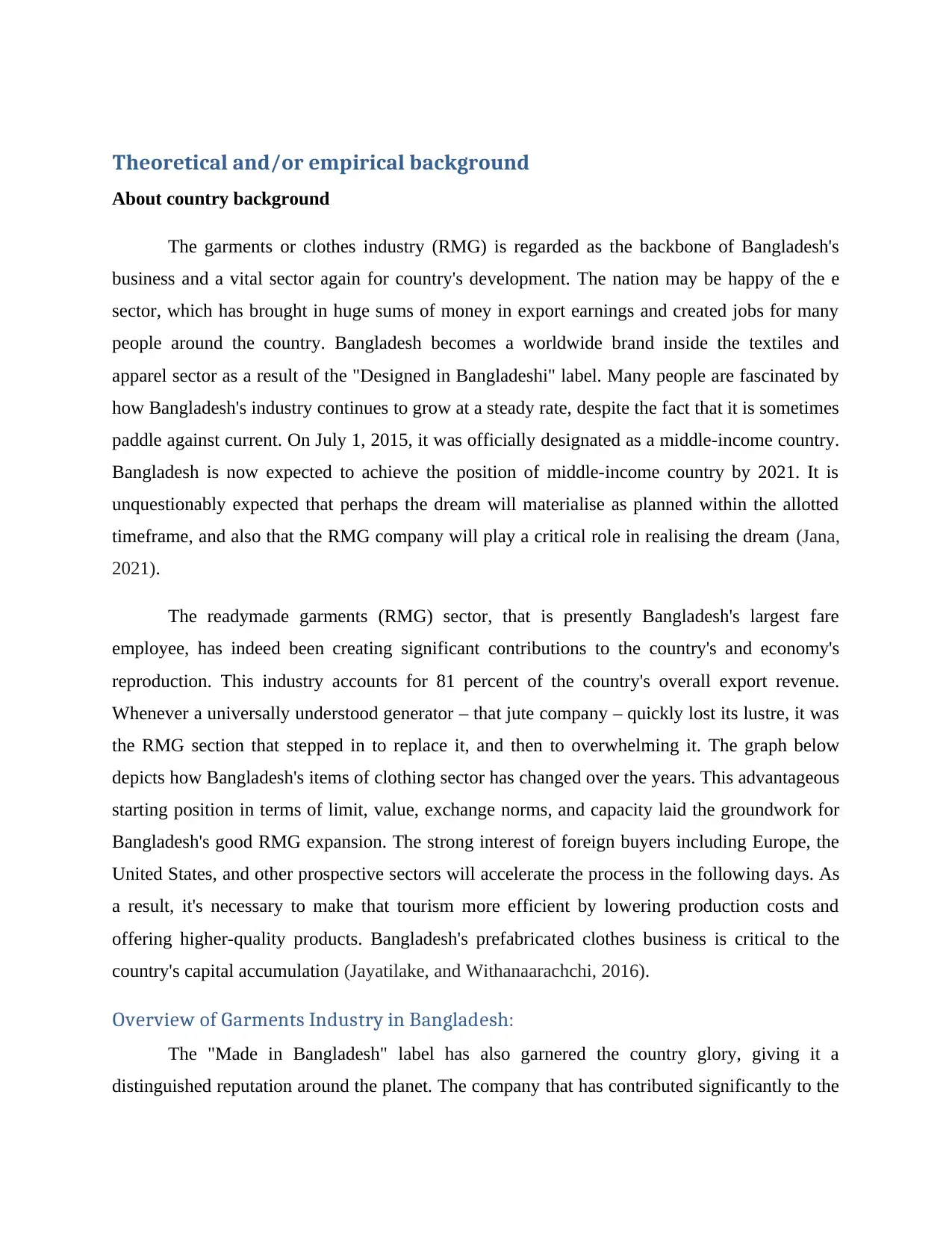
Theoretical and/or empirical background
About country background
The garments or clothes industry (RMG) is regarded as the backbone of Bangladesh's
business and a vital sector again for country's development. The nation may be happy of the e
sector, which has brought in huge sums of money in export earnings and created jobs for many
people around the country. Bangladesh becomes a worldwide brand inside the textiles and
apparel sector as a result of the "Designed in Bangladeshi" label. Many people are fascinated by
how Bangladesh's industry continues to grow at a steady rate, despite the fact that it is sometimes
paddle against current. On July 1, 2015, it was officially designated as a middle-income country.
Bangladesh is now expected to achieve the position of middle-income country by 2021. It is
unquestionably expected that perhaps the dream will materialise as planned within the allotted
timeframe, and also that the RMG company will play a critical role in realising the dream (Jana,
2021).
The readymade garments (RMG) sector, that is presently Bangladesh's largest fare
employee, has indeed been creating significant contributions to the country's and economy's
reproduction. This industry accounts for 81 percent of the country's overall export revenue.
Whenever a universally understood generator – that jute company – quickly lost its lustre, it was
the RMG section that stepped in to replace it, and then to overwhelming it. The graph below
depicts how Bangladesh's items of clothing sector has changed over the years. This advantageous
starting position in terms of limit, value, exchange norms, and capacity laid the groundwork for
Bangladesh's good RMG expansion. The strong interest of foreign buyers including Europe, the
United States, and other prospective sectors will accelerate the process in the following days. As
a result, it's necessary to make that tourism more efficient by lowering production costs and
offering higher-quality products. Bangladesh's prefabricated clothes business is critical to the
country's capital accumulation (Jayatilake, and Withanaarachchi, 2016).
Overview of Garments Industry in Bangladesh:
The "Made in Bangladesh" label has also garnered the country glory, giving it a
distinguished reputation around the planet. The company that has contributed significantly to the
About country background
The garments or clothes industry (RMG) is regarded as the backbone of Bangladesh's
business and a vital sector again for country's development. The nation may be happy of the e
sector, which has brought in huge sums of money in export earnings and created jobs for many
people around the country. Bangladesh becomes a worldwide brand inside the textiles and
apparel sector as a result of the "Designed in Bangladeshi" label. Many people are fascinated by
how Bangladesh's industry continues to grow at a steady rate, despite the fact that it is sometimes
paddle against current. On July 1, 2015, it was officially designated as a middle-income country.
Bangladesh is now expected to achieve the position of middle-income country by 2021. It is
unquestionably expected that perhaps the dream will materialise as planned within the allotted
timeframe, and also that the RMG company will play a critical role in realising the dream (Jana,
2021).
The readymade garments (RMG) sector, that is presently Bangladesh's largest fare
employee, has indeed been creating significant contributions to the country's and economy's
reproduction. This industry accounts for 81 percent of the country's overall export revenue.
Whenever a universally understood generator – that jute company – quickly lost its lustre, it was
the RMG section that stepped in to replace it, and then to overwhelming it. The graph below
depicts how Bangladesh's items of clothing sector has changed over the years. This advantageous
starting position in terms of limit, value, exchange norms, and capacity laid the groundwork for
Bangladesh's good RMG expansion. The strong interest of foreign buyers including Europe, the
United States, and other prospective sectors will accelerate the process in the following days. As
a result, it's necessary to make that tourism more efficient by lowering production costs and
offering higher-quality products. Bangladesh's prefabricated clothes business is critical to the
country's capital accumulation (Jayatilake, and Withanaarachchi, 2016).
Overview of Garments Industry in Bangladesh:
The "Made in Bangladesh" label has also garnered the country glory, giving it a
distinguished reputation around the planet. The company that has contributed significantly to the
Paraphrase This Document
Need a fresh take? Get an instant paraphrase of this document with our AI Paraphraser
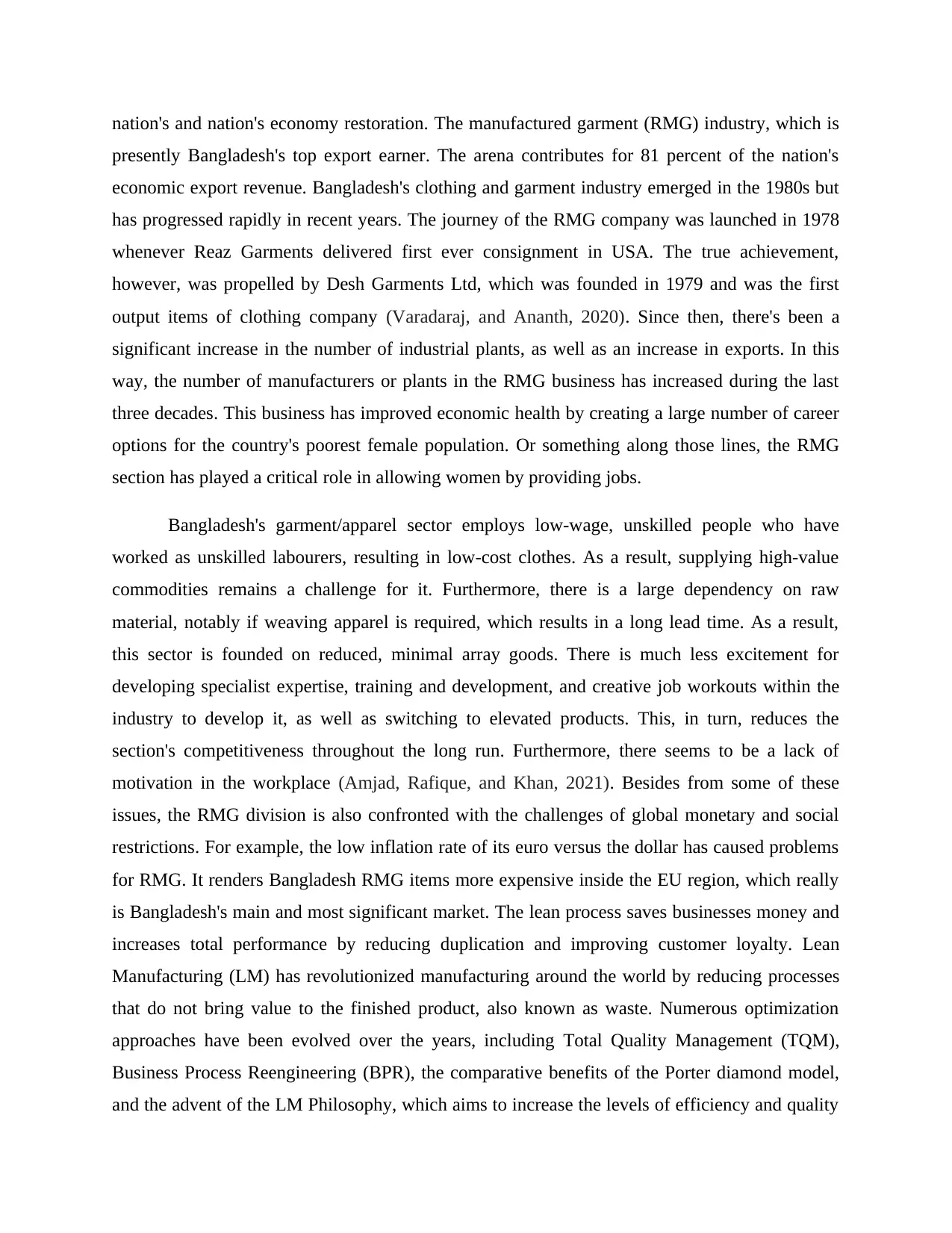
nation's and nation's economy restoration. The manufactured garment (RMG) industry, which is
presently Bangladesh's top export earner. The arena contributes for 81 percent of the nation's
economic export revenue. Bangladesh's clothing and garment industry emerged in the 1980s but
has progressed rapidly in recent years. The journey of the RMG company was launched in 1978
whenever Reaz Garments delivered first ever consignment in USA. The true achievement,
however, was propelled by Desh Garments Ltd, which was founded in 1979 and was the first
output items of clothing company (Varadaraj, and Ananth, 2020). Since then, there's been a
significant increase in the number of industrial plants, as well as an increase in exports. In this
way, the number of manufacturers or plants in the RMG business has increased during the last
three decades. This business has improved economic health by creating a large number of career
options for the country's poorest female population. Or something along those lines, the RMG
section has played a critical role in allowing women by providing jobs.
Bangladesh's garment/apparel sector employs low-wage, unskilled people who have
worked as unskilled labourers, resulting in low-cost clothes. As a result, supplying high-value
commodities remains a challenge for it. Furthermore, there is a large dependency on raw
material, notably if weaving apparel is required, which results in a long lead time. As a result,
this sector is founded on reduced, minimal array goods. There is much less excitement for
developing specialist expertise, training and development, and creative job workouts within the
industry to develop it, as well as switching to elevated products. This, in turn, reduces the
section's competitiveness throughout the long run. Furthermore, there seems to be a lack of
motivation in the workplace (Amjad, Rafique, and Khan, 2021). Besides from some of these
issues, the RMG division is also confronted with the challenges of global monetary and social
restrictions. For example, the low inflation rate of its euro versus the dollar has caused problems
for RMG. It renders Bangladesh RMG items more expensive inside the EU region, which really
is Bangladesh's main and most significant market. The lean process saves businesses money and
increases total performance by reducing duplication and improving customer loyalty. Lean
Manufacturing (LM) has revolutionized manufacturing around the world by reducing processes
that do not bring value to the finished product, also known as waste. Numerous optimization
approaches have been evolved over the years, including Total Quality Management (TQM),
Business Process Reengineering (BPR), the comparative benefits of the Porter diamond model,
and the advent of the LM Philosophy, which aims to increase the levels of efficiency and quality
presently Bangladesh's top export earner. The arena contributes for 81 percent of the nation's
economic export revenue. Bangladesh's clothing and garment industry emerged in the 1980s but
has progressed rapidly in recent years. The journey of the RMG company was launched in 1978
whenever Reaz Garments delivered first ever consignment in USA. The true achievement,
however, was propelled by Desh Garments Ltd, which was founded in 1979 and was the first
output items of clothing company (Varadaraj, and Ananth, 2020). Since then, there's been a
significant increase in the number of industrial plants, as well as an increase in exports. In this
way, the number of manufacturers or plants in the RMG business has increased during the last
three decades. This business has improved economic health by creating a large number of career
options for the country's poorest female population. Or something along those lines, the RMG
section has played a critical role in allowing women by providing jobs.
Bangladesh's garment/apparel sector employs low-wage, unskilled people who have
worked as unskilled labourers, resulting in low-cost clothes. As a result, supplying high-value
commodities remains a challenge for it. Furthermore, there is a large dependency on raw
material, notably if weaving apparel is required, which results in a long lead time. As a result,
this sector is founded on reduced, minimal array goods. There is much less excitement for
developing specialist expertise, training and development, and creative job workouts within the
industry to develop it, as well as switching to elevated products. This, in turn, reduces the
section's competitiveness throughout the long run. Furthermore, there seems to be a lack of
motivation in the workplace (Amjad, Rafique, and Khan, 2021). Besides from some of these
issues, the RMG division is also confronted with the challenges of global monetary and social
restrictions. For example, the low inflation rate of its euro versus the dollar has caused problems
for RMG. It renders Bangladesh RMG items more expensive inside the EU region, which really
is Bangladesh's main and most significant market. The lean process saves businesses money and
increases total performance by reducing duplication and improving customer loyalty. Lean
Manufacturing (LM) has revolutionized manufacturing around the world by reducing processes
that do not bring value to the finished product, also known as waste. Numerous optimization
approaches have been evolved over the years, including Total Quality Management (TQM),
Business Process Reengineering (BPR), the comparative benefits of the Porter diamond model,
and the advent of the LM Philosophy, which aims to increase the levels of efficiency and quality
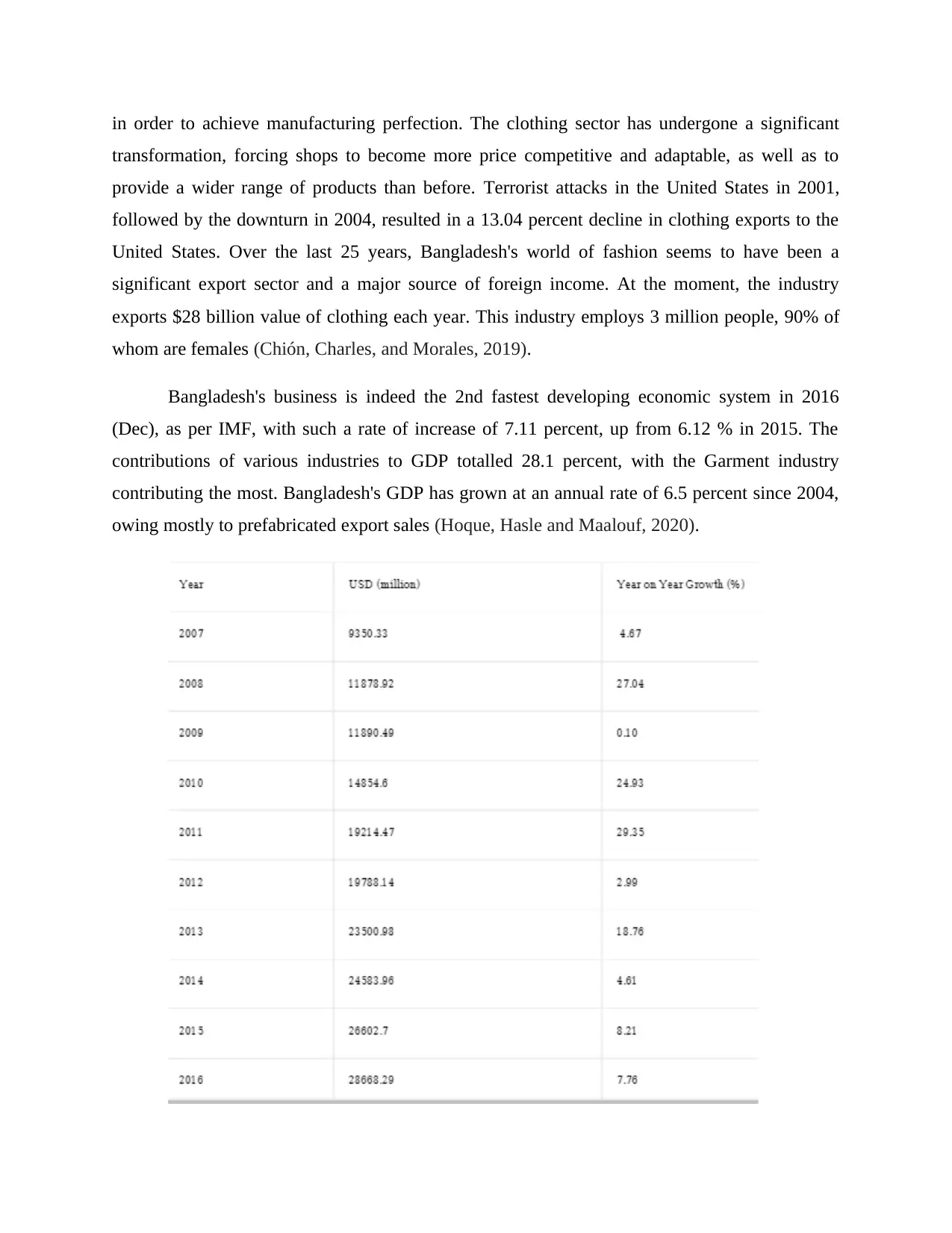
in order to achieve manufacturing perfection. The clothing sector has undergone a significant
transformation, forcing shops to become more price competitive and adaptable, as well as to
provide a wider range of products than before. Terrorist attacks in the United States in 2001,
followed by the downturn in 2004, resulted in a 13.04 percent decline in clothing exports to the
United States. Over the last 25 years, Bangladesh's world of fashion seems to have been a
significant export sector and a major source of foreign income. At the moment, the industry
exports $28 billion value of clothing each year. This industry employs 3 million people, 90% of
whom are females (Chión, Charles, and Morales, 2019).
Bangladesh's business is indeed the 2nd fastest developing economic system in 2016
(Dec), as per IMF, with such a rate of increase of 7.11 percent, up from 6.12 % in 2015. The
contributions of various industries to GDP totalled 28.1 percent, with the Garment industry
contributing the most. Bangladesh's GDP has grown at an annual rate of 6.5 percent since 2004,
owing mostly to prefabricated export sales (Hoque, Hasle and Maalouf, 2020).
transformation, forcing shops to become more price competitive and adaptable, as well as to
provide a wider range of products than before. Terrorist attacks in the United States in 2001,
followed by the downturn in 2004, resulted in a 13.04 percent decline in clothing exports to the
United States. Over the last 25 years, Bangladesh's world of fashion seems to have been a
significant export sector and a major source of foreign income. At the moment, the industry
exports $28 billion value of clothing each year. This industry employs 3 million people, 90% of
whom are females (Chión, Charles, and Morales, 2019).
Bangladesh's business is indeed the 2nd fastest developing economic system in 2016
(Dec), as per IMF, with such a rate of increase of 7.11 percent, up from 6.12 % in 2015. The
contributions of various industries to GDP totalled 28.1 percent, with the Garment industry
contributing the most. Bangladesh's GDP has grown at an annual rate of 6.5 percent since 2004,
owing mostly to prefabricated export sales (Hoque, Hasle and Maalouf, 2020).
⊘ This is a preview!⊘
Do you want full access?
Subscribe today to unlock all pages.

Trusted by 1+ million students worldwide
1 out of 42
Related Documents
Your All-in-One AI-Powered Toolkit for Academic Success.
+13062052269
info@desklib.com
Available 24*7 on WhatsApp / Email
![[object Object]](/_next/static/media/star-bottom.7253800d.svg)
Unlock your academic potential
Copyright © 2020–2025 A2Z Services. All Rights Reserved. Developed and managed by ZUCOL.





